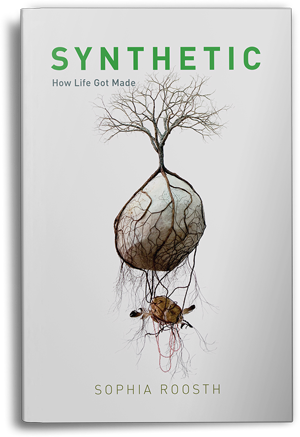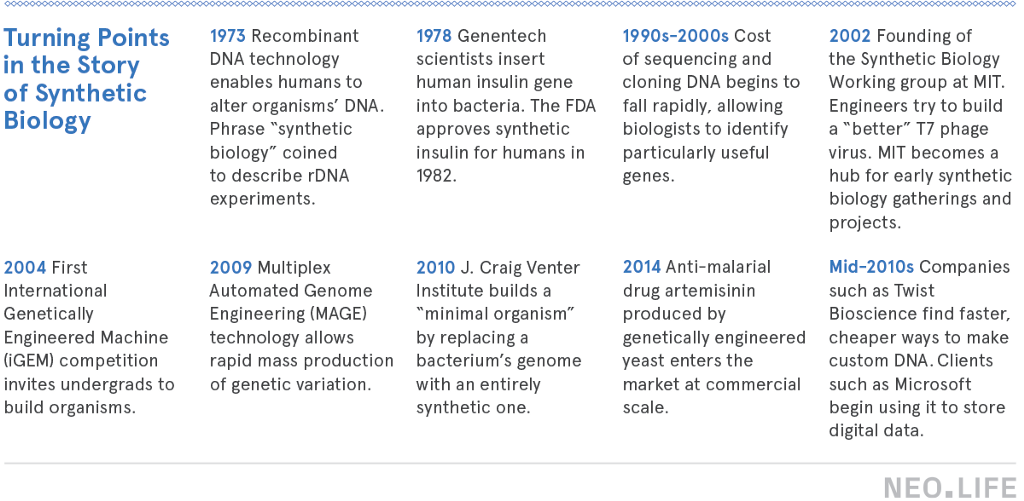Q&A
The Audacity of Synthetic Biologists
Sophia Roosth puts big questions to the people who are reviving extinct species and building organisms from scratch.
Molecular biology tells us that even the simplest cells are confoundingly complex and that to understand them, scientists must experiment on and observe cells. But the subfield of synthetic biology counters: what if the best way to understand cells is to just build them from scratch?
Science historian and anthropologist Sophia Roosth spent nearly a decade observing and interviewing self-declared synthetic biologists, a loosely defined cohort of engineers, scientists, and citizens who design and build artificial organisms.
Today synthetic biology undergirds applications in many fields, including pharmaceuticals, agriculture, and biofuels and other chemicals. Investors are pouring more than $1 billion into synthetic biology companies each year. But Roosth began her fieldwork in an earlier phase, at MIT in the mid-2000s. That led her into conversations with biohackers, electrical-engineers-turned-microbe-designers, leaders of pharma startups, scientific “copyleft” advocates, and distinguished biologists who hope to “resurrect” extinct species through 21st century biotechnology. Though their goals and methods are diverse, Roosth noticed several common threads—especially that synthetic biologists try to “know” the biological world by designing and constructing new lifeforms.
Genomes that have evolved in nature over millions of years are full of overlapping sequences, incomplete remnants of old genes, and long stretches of DNA with no discernable purpose. Synthetic biologists eschew that messiness; their organisms are made to fit the synthetic biologist’s purposes and aesthetics. In most synbio operations, any artificial organisms that don’t fit the mold are discarded. For Roosth, that raised a question: What ideas, assumptions, and goals do synthetic biologists bring to this work?
Roosth, a professor at Harvard, distilled her observations into an anthology-like book called Synthetic: How Life Got Made, and I called her to find out more. Here are a few of the highlights, edited for length and clarity.

Going back to the beginning, why write an ethnography of synthetic biologists?
I was curious about a few things. One was: How is bioengineering being harnessed both for design projects and as a kind of pedagogical tool? And I was interested in this democratization of engineering. What does it mean to have undergraduate students designing organisms?
The people were coming from electrical engineering, computer science, among other fields. What I noticed was that moving from a home discipline like electrical engineering into synthetic biology, people were also importing certain metaphors and ways of thinking.
Can you give an example?
When Drew Endy [now a Stanford professor] was a grad student, he sought to build a computational model that would predict the behavior of the bacteriophage T7. Now, the phage is a really simple, well-characterized entity. It’s been studied in labs for 60 years, and it doesn’t do that much.
But the computational model was a very poor predictor of T7’s behavior. And while it might seem common sense to some people that that meant there was something wrong with the model, he instead inferred that there was something wrong with the virus.
That [raised] a series of questions both for him and for his colleagues about what it would mean for a biological entity to be well-designed. And what it meant for it to be well designed, [Endy decided], was for it to be comprehensible, that is understandable to humans. Which is a radically different definition of what counts as good design.
You say in your book that synthetic biologists are complicating our definitions of lineage and related-ness. How so?
The question that arises when you look at an engineered microbe — say, a bacteria that contains lots of different genes from very diverse species is: how do you then place that on any kind of taxonomic tree or lineage?
Some people would actually cite the way that model has broken down in recent years because of the increasing research about lateral gene transfer [which is when microbes swap genes among themselves]. Bioengineering is considered by some synthetic biologists to be a difference of degree but not of kind from what nature does on its own, which is mix lots of different genes together.

In the final chapter, you discuss the “de-extinction movement,” which proposes to resurrect extinct species through bioengineering. How does the de-extinction movement connect to the rest of synthetic biology, and how is it different?
I think the de-extinction movement is the most extreme, media-genic version of synthetic biology.
Efforts to “resurrect” extinct species involve cobbling together lots of different genetic material. For example, the woolly mammoth project includes several key genes that were sequenced from woolly mammoth tissue, but those would be ported into an elephant genome. So then the question is: when is something really a woolly mammoth and when is it just sort of a fancy elephant with tusks and really thick hair?
When I asked de-extinction biologists this question … the answer was, “Well, if it looks enough like that extinct species, then it is that [species].”
Which brings us back to the bacteriophage: when is it a successful design project? Well, if it’s able to infect bacteria, then that’s a good phage. If it’s easier to understand, then it’s a good phage. Perhaps you could say something similar about passenger pigeons and woolly mammoths.
Late in the book, you make a point about synthetic biology becoming more “normal,” at least in terms of how the public perceives it. What does that trend mean to you?
A nice earlier example of this is recombinant DNA research. Recombinant DNA was considered to be a huge deal in the 1970s with regard to ethics and the ontology of what was being made, and now it’s something that’s done in most biology labs without even thinking twice about it.
That’s why I thought it was important to write this book now, because it’s much more interesting to track these formations, biological and cultural formations, when they’re still remarkable and while they’re still up for debate. Because once they cease to be remarkable, we cease to ask important questions about them.












